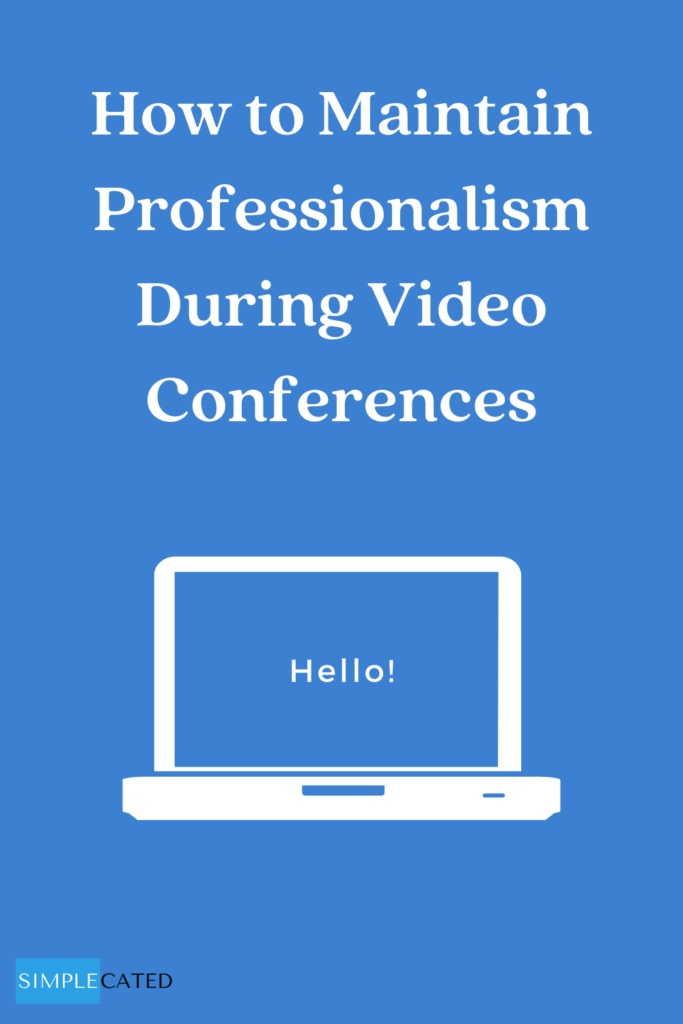With so many employees working from home right now – and many for the first time – you don’t have to look far to find stories of video conferencing fails. We’re hearing about people not wearing pants, pets interrupting meetings, children screaming, and people going to the bathroom while the cameras are still on. While these stories provide comic relief (mainly because they happened to someone else), there can be a serious side to this too.
As a manager, you’re working hard to keep your team connected and productive, and video conferences provide a great way to do that. It’s also important to remember that video conferences are work-related. A work meeting is still part of the job, regardless of where or how it’s happening. Employment laws still apply, as do your company policies. Certainly, we need to have understanding for things that are unavoidable, like a child needing something from his or her parent or technical glitches during presentations. When it comes to professionalism, though, your expectations should be exactly the same as if you were onsite together. If something could be offensive in an in-person meeting, then it should also be avoided in a remote meeting. If you don’t insist on professionalism, you’ll open yourself up to employee complaints and investigations. Plus, once you’re ultimately back onsite together, you’ll have a lot of work to do to reset expectations. People can have a variety of perspectives on what’s appropriate and what’s not, so be proactive in setting the expectations so you can ensure everyone is on the same page before you have an issue.
Have a basic dress code policy.
You don’t have to apply your entire dress code policy, but at least keep some basic expectations like pants and shirts that don’t contain offensive language. No one needs to see anyone’s pajamas. Enforcing some dress code expectations is one of the easiest ways to retain the expectation of professionalism because knowing you’re dressing for work gets you in the mindset for work. If employees will be reflecting the company, such as making a pitch to a new client, then you may want them to abide by your regular dress code.
Laughter is good medicine – but be sensitive.
With the casual feel of video conferencing, it’s easy for it to become a time of laughing and joking. Laughter can be a great stress-reliever, and you want to try to keep spirits up – just be aware of your employees’ needs. While many people are enjoying a more relaxed pace right now, others are experiencing a very different dynamic. Having sick loved ones they can’t visit, experiencing the loss of a loved one, or worrying about family and friends who are working in healthcare or other front-line jobs could all be things your employees are dealing with. A marketing consultant shared a story about a co-worker who started sobbing during a video conference while others were having a light-hearted conversation. We need to make sure we are sensitive to what others are experiencing.
If you don’t already know how your employees are doing, find out at the beginning of the meeting. While body language is harder to read online, pay attention to what you are able to see. If you know employees are dealing with difficult situations, ask their permission before mentioning it to others to make sure they feel comfortable discussing it.
Expect professional and respectful behavior.
Your expectations regarding behavior and the content of communication should be exactly the same as when onsite. If sleeping at work isn’t allowed, then sleeping during video conferences isn’t allowed either. Disrespectful language or inappropriate jokes wouldn’t be allowed onsite and likewise shouldn’t be allowed in any other work setting. You don’t want a racial or sexual harassment complaint on your hands. Remind your employees that work is work, and the same expectations still apply. This applies to any chat features as well. Any communication during work, whether written or verbal, should remain professional and respectful and abide by your company policies. (For more about enforcing anti-discrimination and anti-harassment policies and having a workplace culture that discourages this type of behavior, check out this podcast discussion.)
Request a professional environment.
Not everyone has a home office or a laptop they can move around, so employees will be working in all kinds of rooms and settings. I personally enjoy seeing other people’s homes and learning more about their personal style. With that said, there is a boundary to what’s appropriate. The environment your employees bring to the meeting matters, so remind them to help create a professional environment. Some interruptions are going to happen – children will need something, dogs will bark, others will be talking in the background. Be flexible and understanding. You’ll no doubt bring your own interruptions at times as well.
The concern is more about items that are inappropriate in the workplace, such as another person walking past nude, offensive art on the wall, or bringing the meeting to the bathroom. Remind your employees that they are responsible for what they allow to be displayed to others during a work meeting. Everyone needs to ensure they don’t make anyone else uncomfortable by the environment they bring to the meeting.
Be sure to take the time to learn what options you have with the technology you’re using for your video conferences. You may have the ability to turn off individual video or mute someone if you need to. Also, use as secure a connection as you can to try to avoid hacking. If you’re able to have a password for your meeting, that’s a good idea.
Address concerns promptly.
If a concern does arise, address it directly with the employee as soon as you can. Effectively managing the performance of remote employees is very important, just like it is when everyone is onsite. Outline what specifically was concerning and ask about why it happened, just like you would with any performance concern. Explain why it’s an issue and how it affects the team. If the behavior is something that the whole team witnessed, consider offering the employee the chance to apologize, but don’t force it. You could consider briefly revisiting the expectations during the next team meeting and reminding everyone of the importance of abiding by them. Addressing any issues promptly demonstrates to your team that you take this seriously, which can also help discourage employees from repeatedly not following directions, and will help you and your team maintain professionalism during video conferences.
Photo credit: By Rido / Canva





